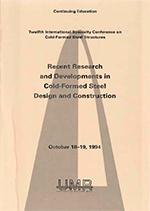Location
Saint Louis, Missouri
Session Dates
18 Oct 1994
Abstract
CAN/CSA-S136-M89 and the AISI Specification on Cold Formed Steel Design use different methods to determine the effective width of multiple stiffened compressive elements when no local buckling in the sub-elements occurs. Both methods replace the multiple stiffened element with a flat plate element centered at the neutral axis of the multiple stiffened element. The methods differ in assigning an equivalent thickness to the straight line element. The AISI method provides sufficient thickness to match the moment of inertia of the multiple stiffened element, while the S136 method makes use of orthotropic plate theory, however, dealing only with the elastic buckling component. For a given geometry, they predict different effective widths. In this paper, experimental data is compared with the predicted values of each method and conclusions are drawn from these comparisons. Representative hat sections were subjected to uniformly distributed loads using a vacuum chamber. Profiles with one, two, three and four· intermediate stiffeners were tested, using three material thicknesses for each configuration of stiffeners.
Department(s)
Civil, Architectural and Environmental Engineering
Research Center/Lab(s)
Wei-Wen Yu Center for Cold-Formed Steel Structures
Meeting Name
12th International Specialty Conference on Cold-Formed Steel Structures
Publisher
University of Missouri--Rolla
Document Version
Final Version
Rights
© 1994 University of Missouri--Rolla, All rights reserved.
Document Type
Article - Conference proceedings
File Type
text
Language
English
Recommended Citation
Sommerstein, M.; Papazian, R. P.; and Schuster, R. M., "Multiple Stiffened Deck Profiles" (1994). CCFSS Proceedings of International Specialty Conference on Cold-Formed Steel Structures (1971 - 2018). 2.
https://scholarsmine.mst.edu/isccss/12iccfss/12iccfss-session4/2
Multiple Stiffened Deck Profiles
Saint Louis, Missouri
CAN/CSA-S136-M89 and the AISI Specification on Cold Formed Steel Design use different methods to determine the effective width of multiple stiffened compressive elements when no local buckling in the sub-elements occurs. Both methods replace the multiple stiffened element with a flat plate element centered at the neutral axis of the multiple stiffened element. The methods differ in assigning an equivalent thickness to the straight line element. The AISI method provides sufficient thickness to match the moment of inertia of the multiple stiffened element, while the S136 method makes use of orthotropic plate theory, however, dealing only with the elastic buckling component. For a given geometry, they predict different effective widths. In this paper, experimental data is compared with the predicted values of each method and conclusions are drawn from these comparisons. Representative hat sections were subjected to uniformly distributed loads using a vacuum chamber. Profiles with one, two, three and four· intermediate stiffeners were tested, using three material thicknesses for each configuration of stiffeners.



